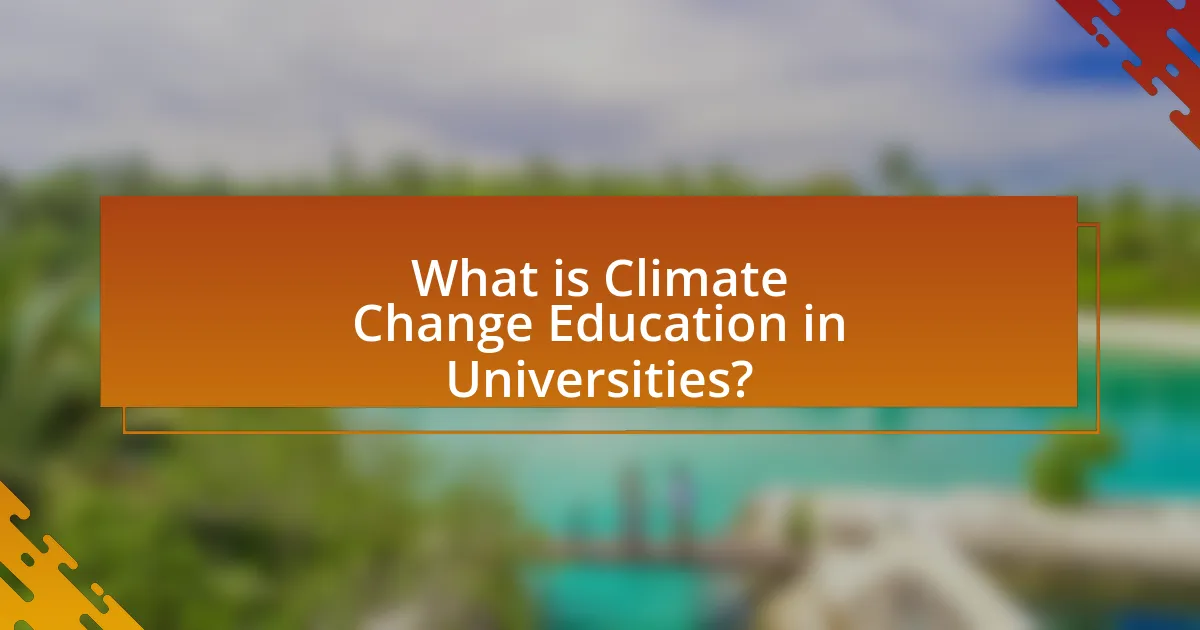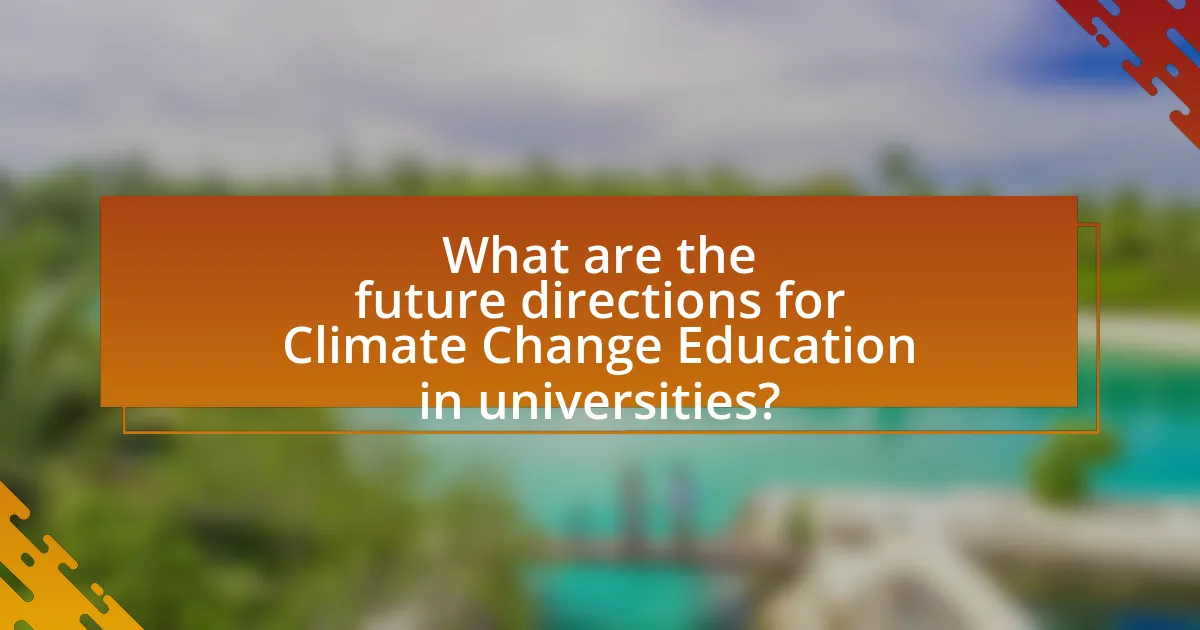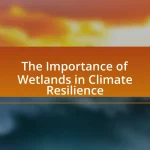Climate Change Education in universities involves the integration of climate change topics into academic curricula, research, and community engagement to equip students with essential knowledge and skills. This educational approach is crucial for fostering climate literacy among future leaders and professionals, enhancing critical thinking and problem-solving abilities necessary for sustainable solutions. The article outlines the importance of climate change education, key objectives, current trends, innovative teaching methods, and best practices for implementation, while also addressing challenges such as curriculum integration, faculty training, and funding. Additionally, it discusses strategies for effective course design, collaboration with external organizations, and the role of faculty in promoting climate awareness and action.

What is Climate Change Education in Universities?
Climate Change Education in universities refers to the systematic integration of climate change topics into academic curricula, research, and community engagement initiatives. This educational approach aims to equip students with the knowledge and skills necessary to understand and address the complexities of climate change. Evidence shows that universities play a crucial role in fostering climate literacy, as they are responsible for educating future leaders and professionals who will confront climate-related challenges. According to a report by the United Nations Educational, Scientific and Cultural Organization (UNESCO), effective climate change education enhances critical thinking and problem-solving skills, which are essential for developing sustainable solutions.
Why is Climate Change Education important in higher education?
Climate Change Education is important in higher education because it equips students with the knowledge and skills necessary to address the complex challenges posed by climate change. This education fosters critical thinking and problem-solving abilities, enabling future leaders to develop innovative solutions for sustainability. Research indicates that universities play a crucial role in shaping public understanding and policy regarding climate issues, as they are centers for research and innovation. For instance, a study by the Intergovernmental Panel on Climate Change highlights that education is essential for promoting awareness and action on climate change, emphasizing the need for informed citizens who can engage in climate-related decision-making.
What are the key objectives of Climate Change Education?
The key objectives of Climate Change Education are to raise awareness about climate change, promote critical thinking, and empower individuals to take action. These objectives aim to inform students about the scientific basis of climate change, its impacts on ecosystems and societies, and the importance of sustainability. Research indicates that effective climate change education enhances students’ understanding of environmental issues and fosters a sense of responsibility towards mitigating climate change effects, as highlighted in the Intergovernmental Panel on Climate Change reports.
How does Climate Change Education impact student awareness and engagement?
Climate Change Education significantly enhances student awareness and engagement by providing critical knowledge about environmental issues and fostering a sense of responsibility. Research indicates that when students are educated about climate change, they demonstrate increased understanding of its causes and effects, leading to greater concern for environmental sustainability. For instance, a study published in the Journal of Environmental Education found that students who participated in climate change curricula showed a 30% increase in their awareness of climate-related issues compared to those who did not receive such education. This heightened awareness often translates into active engagement, as students are more likely to participate in sustainability initiatives and advocate for policy changes.
What are the current trends in Climate Change Education at universities?
Current trends in Climate Change Education at universities include the integration of interdisciplinary approaches, experiential learning, and the incorporation of climate justice themes. Universities are increasingly adopting curricula that combine scientific, social, and economic perspectives on climate change, fostering a holistic understanding among students. For instance, programs often emphasize hands-on experiences, such as fieldwork and community engagement, which enhance practical skills and awareness. Additionally, there is a growing focus on climate justice, addressing the social implications of climate change and promoting equity in climate solutions. Research indicates that these trends are essential for preparing students to tackle complex climate challenges effectively.
How are universities integrating climate change into their curricula?
Universities are integrating climate change into their curricula by incorporating interdisciplinary courses, research initiatives, and sustainability practices across various disciplines. For instance, many institutions now offer dedicated programs in environmental science, climate policy, and sustainable development, which emphasize the scientific, social, and economic aspects of climate change. Additionally, universities are embedding climate change topics into existing courses in fields such as business, engineering, and public health, ensuring that all students understand its implications. According to a report by the Association for the Advancement of Sustainability in Higher Education, over 1,000 institutions have committed to sustainability-focused education, demonstrating a significant shift towards climate-conscious curricula.
What innovative teaching methods are being used in Climate Change Education?
Innovative teaching methods in Climate Change Education include experiential learning, interdisciplinary approaches, and the use of digital technologies. Experiential learning engages students through hands-on activities, such as field studies and simulations, which enhance understanding of climate impacts. Interdisciplinary approaches integrate knowledge from various fields, fostering a holistic view of climate issues. Digital technologies, including online platforms and interactive tools, facilitate remote learning and collaboration, making education more accessible. Research indicates that these methods improve student engagement and retention of knowledge, as evidenced by studies showing increased motivation and understanding in courses that utilize these strategies.

What are the best practices for implementing Climate Change Education?
The best practices for implementing Climate Change Education include integrating interdisciplinary approaches, fostering critical thinking, and promoting community engagement. Interdisciplinary approaches allow students to understand climate change from various perspectives, such as science, policy, and ethics, enhancing their overall comprehension. Fostering critical thinking equips students to analyze and evaluate climate-related information critically, which is essential for informed decision-making. Promoting community engagement encourages students to apply their knowledge in real-world contexts, facilitating a deeper connection to the subject matter. Research indicates that programs incorporating these practices lead to increased student awareness and action regarding climate issues, as evidenced by studies from the National Oceanic and Atmospheric Administration, which highlight the effectiveness of hands-on learning experiences in improving climate literacy.
How can universities effectively design Climate Change courses?
Universities can effectively design Climate Change courses by integrating interdisciplinary approaches that encompass scientific, social, and economic perspectives. This method ensures that students gain a comprehensive understanding of climate change’s multifaceted impacts. Research indicates that courses incorporating real-world case studies and experiential learning significantly enhance student engagement and retention of knowledge. For instance, a study published in the Journal of Environmental Education found that students who participated in hands-on projects related to climate change demonstrated a 30% increase in knowledge retention compared to traditional lecture-based formats. Additionally, collaborating with local communities and organizations can provide practical insights and foster a sense of responsibility among students, further enriching the educational experience.
What interdisciplinary approaches enhance Climate Change Education?
Interdisciplinary approaches that enhance Climate Change Education include integrating environmental science, social sciences, economics, and policy studies. This integration allows for a comprehensive understanding of climate change impacts and solutions. For instance, research by the National Academy of Sciences highlights that combining these disciplines fosters critical thinking and problem-solving skills among students, enabling them to address complex climate issues effectively. Furthermore, collaborative projects that involve multiple fields, such as engineering and public health, have been shown to produce innovative solutions and engage students in real-world applications, thereby reinforcing the importance of a multidisciplinary perspective in climate education.
How can universities foster collaboration with external organizations?
Universities can foster collaboration with external organizations by establishing partnerships that align academic research with industry needs. These partnerships can be facilitated through joint research projects, internships, and community engagement initiatives that address climate change challenges. For instance, the University of California, Davis, collaborates with various agricultural organizations to develop sustainable practices, demonstrating how academic expertise can directly benefit external stakeholders. Such collaborations not only enhance educational outcomes but also contribute to real-world solutions in climate change mitigation and adaptation.
What role do faculty play in Climate Change Education?
Faculty play a crucial role in Climate Change Education by designing curricula, conducting research, and engaging students in discussions about climate issues. They are responsible for integrating climate change topics across various disciplines, ensuring that students understand the scientific, social, and economic implications of climate change. Research indicates that faculty-led initiatives, such as interdisciplinary courses and community outreach programs, enhance student awareness and engagement, fostering a more informed and proactive generation regarding climate action.
How can faculty be supported in teaching climate change topics?
Faculty can be supported in teaching climate change topics through professional development programs that enhance their knowledge and teaching strategies. These programs can include workshops, seminars, and access to interdisciplinary resources that focus on the latest climate science, pedagogical techniques, and curriculum development. Research indicates that faculty who participate in such programs are more effective in conveying complex climate issues, as evidenced by improved student engagement and understanding (National Academies of Sciences, Engineering, and Medicine, 2019). Additionally, providing faculty with access to collaborative networks and partnerships with climate experts can further enrich their teaching and ensure that they are equipped with current, evidence-based information.
What professional development opportunities are available for educators?
Professional development opportunities for educators include workshops, online courses, conferences, and collaborative learning communities focused on climate change education. These opportunities enable educators to enhance their knowledge and teaching strategies related to climate change, which is increasingly recognized as a critical area of study. For instance, organizations like the National Oceanic and Atmospheric Administration (NOAA) and the National Science Teachers Association (NSTA) offer specialized training programs that equip educators with the latest research and teaching methodologies in climate science. Additionally, universities often provide faculty development programs that emphasize interdisciplinary approaches to climate change, fostering collaboration among educators from various fields.

What challenges do universities face in Climate Change Education?
Universities face several challenges in Climate Change Education, including curriculum integration, faculty training, and resource allocation. Integrating climate change topics into existing curricula can be difficult due to the diverse academic disciplines and varying levels of urgency among faculty. Additionally, many educators lack adequate training in climate science, which hampers their ability to teach the subject effectively. Resource allocation is another significant challenge, as universities often struggle to secure funding for climate-related programs and initiatives, limiting their capacity to develop comprehensive educational offerings. These challenges hinder the effectiveness of climate change education and the ability of universities to prepare students for addressing this critical global issue.
What are the common barriers to effective Climate Change Education?
Common barriers to effective Climate Change Education include lack of funding, insufficient training for educators, and limited integration into existing curricula. Funding constraints hinder the development of comprehensive programs and resources, while educators often lack the necessary training to convey complex climate concepts effectively. Additionally, when climate change topics are not integrated into broader educational frameworks, students may not receive a holistic understanding of the issue. Research indicates that these barriers significantly impede the implementation of effective climate education initiatives in universities, as highlighted in studies by the National Academies of Sciences, Engineering, and Medicine.
How does funding impact Climate Change Education initiatives?
Funding significantly enhances Climate Change Education initiatives by providing essential resources for curriculum development, training, and outreach programs. Increased financial support allows universities to create comprehensive educational materials, hire qualified educators, and implement innovative teaching methods. For instance, a study by the National Science Foundation found that institutions with dedicated funding for climate education programs reported a 30% increase in student engagement and understanding of climate issues. This demonstrates that adequate funding directly correlates with the effectiveness and reach of climate change education efforts.
What resistance might educators encounter when teaching climate change?
Educators may encounter resistance from students, parents, and policymakers when teaching climate change. This resistance often stems from political beliefs, misinformation, and a lack of understanding about the scientific consensus on climate change. For instance, a survey conducted by the Pew Research Center in 2020 found that 65% of Americans believe climate change is a major threat, but significant portions of the population still express skepticism, influenced by political affiliations. Additionally, some parents may oppose climate change education due to concerns about its impact on their children’s worldview or fear of alarmism. This resistance can hinder the effective delivery of climate change education and limit students’ understanding of the issue.
How can universities overcome these challenges?
Universities can overcome challenges in climate change education by integrating interdisciplinary curricula that emphasize sustainability and climate science. This approach allows institutions to provide students with a comprehensive understanding of climate issues, fostering critical thinking and problem-solving skills. For instance, the University of California, Berkeley, has developed a Climate Change Studies minor that combines courses from various disciplines, demonstrating the effectiveness of interdisciplinary education in addressing complex climate challenges. Additionally, universities can enhance faculty training and support for climate education, ensuring that educators are equipped with the latest research and teaching methodologies. Implementing these strategies can significantly improve the quality and impact of climate change education in higher education institutions.
What strategies can be implemented to secure funding for climate programs?
To secure funding for climate programs, universities can implement strategies such as establishing partnerships with private sector organizations, applying for government grants, and engaging in crowdfunding initiatives. Partnerships with businesses can provide financial resources and expertise, as companies increasingly seek to invest in sustainability efforts. For instance, the U.S. Department of Energy offers grants specifically for climate-related research, which universities can apply for to support their programs. Additionally, crowdfunding platforms have been successfully used by various educational institutions to raise funds directly from the community, demonstrating public interest and support for climate initiatives. These strategies collectively enhance the financial viability of climate programs in academic settings.
How can universities engage students and faculty in climate initiatives?
Universities can engage students and faculty in climate initiatives by implementing interdisciplinary programs that promote collaboration on sustainability projects. These programs can include hands-on research opportunities, workshops, and community service projects focused on climate action. For instance, a study by the American Association of Colleges and Universities found that experiential learning significantly enhances student engagement and understanding of environmental issues. Additionally, universities can establish sustainability committees that include both students and faculty, fostering a shared responsibility for climate initiatives and encouraging diverse perspectives in decision-making processes.

What are the future directions for Climate Change Education in universities?
Future directions for Climate Change Education in universities include integrating interdisciplinary approaches, enhancing experiential learning, and promoting global collaboration. Universities are increasingly recognizing the need to incorporate diverse fields such as economics, sociology, and environmental science to provide a holistic understanding of climate issues. For instance, programs that combine scientific knowledge with policy-making skills are being developed to prepare students for real-world challenges. Additionally, experiential learning opportunities, such as internships and field studies, are being prioritized to engage students actively in climate action. A report by the United Nations Educational, Scientific and Cultural Organization (UNESCO) emphasizes the importance of education for sustainable development, highlighting that universities must foster partnerships across borders to share knowledge and resources effectively.
How can universities adapt to the evolving landscape of climate change?
Universities can adapt to the evolving landscape of climate change by integrating sustainability into their curricula and operations. This includes developing interdisciplinary programs that focus on climate science, policy, and technology, which can enhance students’ understanding of climate issues. For instance, a study by the Association for the Advancement of Sustainability in Higher Education found that institutions with sustainability-focused programs report higher student engagement and awareness regarding climate change. Additionally, universities can implement green campus initiatives, such as renewable energy projects and sustainable building practices, which not only reduce their carbon footprint but also serve as practical learning environments for students.
What emerging technologies can enhance Climate Change Education?
Emerging technologies that can enhance Climate Change Education include virtual reality (VR), artificial intelligence (AI), and online collaborative platforms. VR allows students to experience climate scenarios firsthand, fostering a deeper understanding of environmental impacts. AI can personalize learning experiences by analyzing student data to tailor educational content, making it more relevant and engaging. Online collaborative platforms facilitate global discussions and projects, enabling students to connect with peers and experts worldwide, thus broadening their perspectives on climate issues. These technologies have been shown to improve engagement and retention in educational settings, as evidenced by studies indicating that immersive learning experiences can increase knowledge retention by up to 75%.
How can universities measure the effectiveness of their climate education programs?
Universities can measure the effectiveness of their climate education programs through a combination of student assessments, surveys, and behavioral changes. By implementing pre- and post-course assessments, universities can quantitatively evaluate knowledge gains among students. Surveys can gauge student attitudes and engagement with climate issues before and after the program, providing qualitative data on shifts in perception. Additionally, tracking behavioral changes, such as increased participation in sustainability initiatives or changes in consumption patterns, offers concrete evidence of the program’s impact. Research indicates that programs incorporating experiential learning and community engagement yield higher effectiveness, as demonstrated by studies showing improved student outcomes in sustainability knowledge and practices.
What practical steps can universities take to improve Climate Change Education?
Universities can improve Climate Change Education by integrating interdisciplinary curricula that encompass environmental science, policy, and ethics. This approach allows students to understand the multifaceted nature of climate change and its societal impacts. For instance, a study by the National Academy of Sciences highlights that interdisciplinary education enhances critical thinking and problem-solving skills, which are essential for addressing climate issues. Additionally, universities can establish partnerships with local communities and organizations to provide hands-on learning experiences, fostering real-world applications of climate knowledge. Implementing sustainability initiatives on campus, such as reducing carbon footprints and promoting renewable energy, also serves as a practical teaching tool, demonstrating commitment to climate action.
What resources are available for universities to enhance their climate curricula?
Universities can enhance their climate curricula through various resources, including interdisciplinary programs, online courses, and partnerships with environmental organizations. For instance, the Association for the Advancement of Sustainability in Higher Education (AASHE) provides a framework for sustainability education and offers resources such as the Sustainability Tracking, Assessment & Rating System (STARS), which helps institutions measure their sustainability efforts. Additionally, platforms like Coursera and edX offer online courses on climate science and sustainability, enabling universities to integrate expert-led content into their curricula. Collaborations with organizations like the United Nations Environment Programme (UNEP) can also provide access to research, case studies, and educational materials that support climate education initiatives.
How can universities create a culture of sustainability on campus?
Universities can create a culture of sustainability on campus by integrating sustainability into their curriculum, promoting sustainable practices, and engaging the campus community. By incorporating sustainability-focused courses and programs, universities educate students on environmental issues and solutions, fostering a mindset geared towards sustainability. For instance, a study by the Association for the Advancement of Sustainability in Higher Education found that institutions with sustainability curricula reported higher student engagement in sustainability initiatives. Additionally, universities can implement sustainable practices such as waste reduction, energy efficiency, and sustainable transportation options, which not only reduce their environmental footprint but also serve as practical examples for students. Engaging the campus community through events, workshops, and partnerships with local organizations further reinforces the importance of sustainability, creating a shared commitment to environmental stewardship.


